Harness Racing:
Indiana's Heritage and the Role of North Vernon
Indiana's Heritage and the Role of North Vernon
By Jim Calli
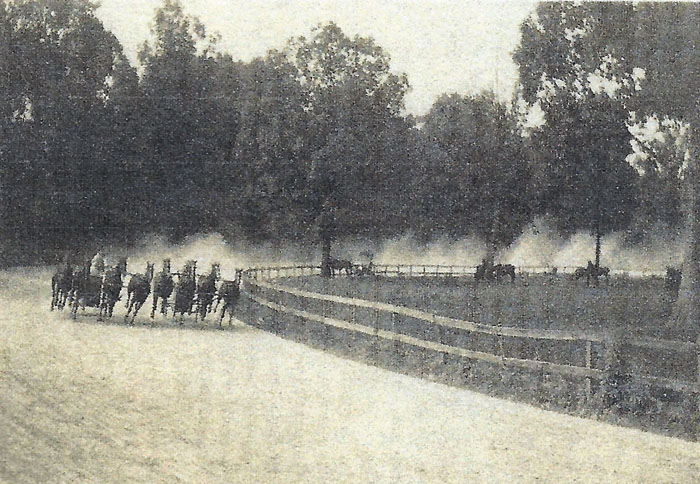
Dan Patch, Greyhound, Worthy Boy. The list goes on with names of harness horses in Indiana.
The above names were the Michael Jordans of their day, their speed the talk of the local sports discussions in every town around Indiana.
The local fairs all had racing as the centerpiece of the event and this was where everyone wanted to be.
What is harness racing? What is a Standardbred? What was North Vernon's role in this industry? All race horses are felt to have descended from Messenger, a thoroughbred from Europe brought to the US in the late 1700's. There was much cross breeding with Morgans and Arabians to produce the Standardbred of which all trotters and pacers are today. Hambletonian, a grandson of Messenger sired over 1300 foals and virtually all Standardbreds racing today come from four of his sons.
Harness racing consists of two gaits, trotting and pacing. In trotting two legs on one side come together while those on the other side go apart. In pacing the legs move together as a unit. Each race has horses of only one gait. Pacers are faster but trotters are considered the "purest" as this was the gait from the buggy days. In harness racing a cart (sulky) is used along with the harness attachments. The driver (not called a jockey here) sits on the cart and in contrast to jockeys, weight is not a major factor since the horses start on the run behind a car specially equipped with wide arms that the horses put their heads next to. The distance raced is usually a mile and all records are at this distance and thereby standardized (hence Standardbred).
Horse racing dates back to around 4000 BC in central Asia and was popular in Europe after the crusades as the Arabian line was brought in. Harness racing is an American institution and grew out of racing on country roads in the horse and buggy days. This was then formalized at county fairs and harness racing was the centerpiece of thousands of country fairs throughout the Midwest, East, for the best horses over the next century. With the advent of the automobile the sport died down and did not surge back till the late 30's and particularly when Roosevelt Raceway in New York City opened and had pari-mutual betting. Its popularity then soared. Greyhound was Horse of the Year in 1937 (The same era as Seabiscuit), establishing a trotting record of 1:55 1/4 for a mile at the Indianapolis Fairgrounds, a record that stood for over 35 years. Dan Patch was then foaled in Indiana and became a nationwide celebrity, traveling the country in his own railway car and setting records (1:55) that stood for over 30 years. He was truly the most celebrated athlete of his time.
Indiana was at the epicenter of the industry yet never was able to reap the benefits of the sports popularity because of the lack of pari-mutual betting in the state. Every state on our borders had this and huge industries and breeding farms sprang up there because the monies from pari mutual supported the tracks and farms with their sires stakes. Vast sums of money went out of Indiana to those neighboring states and horsemen here tried for years to change this but were unsuccessful. By the time this was changed the sport was in decline which continues to this day. This began with the movement of the major race in harness racing, the Hambletonian, from its historic site in Duquoin, Illinois to the Meadowlands, a mega track in New Jersey that offered purses far exceeding what other tracks could keep up with and this money helped to fuel the decline, now virtual absence, of county fair racing as well as a slow death of the major tracks. Casino and off track betting also helped fuel this decline. The only means of resurgence are where slots and casinos have been allowed at the tracks. Paradoxically, Indiana has had a dramatic rise in money in its sires stakes purses due to the casinos, albeit too late. The love of the sport for its beauty and spirit, from racing your neighbor down a country lane to the county fair is gone. The love of the beauty and athleticism of horses is but a memory, and economically it is not viable to those thousands of small owners and drivers who have been the life blood of the sport for years.
My father Dr. Louis Calli, Sr. was in the Army at Fort Knox and happened to buy a horse. When he got out he was driving back to New York and went through North Vernon. He asked if they had a doctor here and Dr. Green was getting older at the time and Dad thought this looked like a good place to raise horses and practice medicine so he stayed, bought the house on State Street and a small farm in Commiskey and his career began. The presence of Curt here was a clear influence on his staying. Our stable along with others was housed at the city park where the race track was well laid out with banked turns and stalls for 30 horses. When the town decided to do away with racing and the fair moved out of town, the track was taken down and Dad bought the farm on highway 50 and built our own track. That farm and track are now plowed and farmed with no sign of the hundreds of horses that roamed the fields.
There were many others as Jennings County was a hotbed of the sport. Russell VanBlaricum had a stable and one of his early workers
was a young woman named Carol Hukill. She worked with Russell and became very successful, driving in races at major tracks, one of the few women drivers
in the country. I remember being at the fair when Carol was driving. I was about eight. She was in a wreck and her foot got caught in the sulky and she
was dragged all around the track. It scared me as this horse was running wild and I jumped up in the truck. She was OK and continued to drive later.
Another main stay of local racing was Dave Howard who worked with Russel VanBlaricum and then built his own track on his farm near the state school. Dave was the last harness horse man in town and has only recently retired. Dave was a true horseman who raised, broke, trained, shoed, and was the vet for all his own horses. The Hill family from Bloomington who loaned much of the memorabilia we have here tonight, were major players in the state industry. My brother Sam Calli drove in his first race at 16 and continued driving the rest of his life. He would cover most of the Indiana fair circuit, all through Ohio and Pennsylvania and raced through most major tracks in North America from Winnipeg, Manitoba to New York City. Dad and Sam bought a stud Mahlon Hanover who had been the top two year old in the country and was an early favorite for the Hambletonian, but then went blind. Most of the horses in the stable were home bred but Dad was always trading and buying and at one point we had over 150 horses. Dad would trade frequently with the Amish who prized harness horses for their buggies when they were too old to race.
Sam was well known throughout the tracks as "Singing Sam". He loved to sing and croon, a la Dean Martin and Frank Sinatra and did this at the bars which were after race venues for the drivers. When the race announcer would call horses at the head of the stretch he would yell. "...and here comes Singing Sam on the move".
Every horseman was always waiting for the "big one", the horse that would win them the envy of other horsemen, and race and beat the best. Very few ever won much money but whether it was a $100 claimer or a Hambletonian winner, the real sport was the competition. My fondest memories are of standing at the fence with Dad at our farm, which is now the Violet and Louis Calli Nature Preserve, and watching the new young colts out in the field every year. With the same belief and hope he would always point to one of the foals and say "Look at that gait, he's a natural trotter, that's going to be the one!"
Primary Interests:
My patients-specifically the management of heart failure and Arrhythmia.
Medical Students-I try to spend more time in teaching and hope I can have an influence to let students see the special privilege medicine is.
Africa-Ann Marie and I have founded Giving Back to Africa in 2003 and this occupies much of our time.
We fund and support an orphanage in Kinshasa, DRC and run a scholar's program for university students at the Protestant University of Congo.
Bicycling-We are fortunate to be able to travel and enjoy mountain terrain riding around the world.
"My life was formed by North Vernon and being fortunate to grow up in an environment of support and wonderful friends. These relationships and my love and gratefulness to this community and my friends only grows with time. Being able to donate the Calli Nature Preserve has been one of my fondest moments. Seeing kids and families and their dogs playing and enjoying the trail give me a great continuing sense of connection with the land I love so much. There is nothing special about me donating it. I'm just lucky enough to have been able to. There was never any question this land should be preserved for people to enjoy it as much as I did."
What is harness racing? What is a Standardbred? What was North Vernon's role in this industry? All race horses are felt to have descended from Messenger, a thoroughbred from Europe brought to the US in the late 1700's. There was much cross breeding with Morgans and Arabians to produce the Standardbred of which all trotters and pacers are today. Hambletonian, a grandson of Messenger sired over 1300 foals and virtually all Standardbreds racing today come from four of his sons.
Harness racing consists of two gaits, trotting and pacing. In trotting two legs on one side come together while those on the other side go apart. In pacing the legs move together as a unit. Each race has horses of only one gait. Pacers are faster but trotters are considered the "purest" as this was the gait from the buggy days. In harness racing a cart (sulky) is used along with the harness attachments. The driver (not called a jockey here) sits on the cart and in contrast to jockeys, weight is not a major factor since the horses start on the run behind a car specially equipped with wide arms that the horses put their heads next to. The distance raced is usually a mile and all records are at this distance and thereby standardized (hence Standardbred).
Horse racing dates back to around 4000 BC in central Asia and was popular in Europe after the crusades as the Arabian line was brought in. Harness racing is an American institution and grew out of racing on country roads in the horse and buggy days. This was then formalized at county fairs and harness racing was the centerpiece of thousands of country fairs throughout the Midwest, East, for the best horses over the next century. With the advent of the automobile the sport died down and did not surge back till the late 30's and particularly when Roosevelt Raceway in New York City opened and had pari-mutual betting. Its popularity then soared. Greyhound was Horse of the Year in 1937 (The same era as Seabiscuit), establishing a trotting record of 1:55 1/4 for a mile at the Indianapolis Fairgrounds, a record that stood for over 35 years. Dan Patch was then foaled in Indiana and became a nationwide celebrity, traveling the country in his own railway car and setting records (1:55) that stood for over 30 years. He was truly the most celebrated athlete of his time.
Indiana was at the epicenter of the industry yet never was able to reap the benefits of the sports popularity because of the lack of pari-mutual betting in the state. Every state on our borders had this and huge industries and breeding farms sprang up there because the monies from pari mutual supported the tracks and farms with their sires stakes. Vast sums of money went out of Indiana to those neighboring states and horsemen here tried for years to change this but were unsuccessful. By the time this was changed the sport was in decline which continues to this day. This began with the movement of the major race in harness racing, the Hambletonian, from its historic site in Duquoin, Illinois to the Meadowlands, a mega track in New Jersey that offered purses far exceeding what other tracks could keep up with and this money helped to fuel the decline, now virtual absence, of county fair racing as well as a slow death of the major tracks. Casino and off track betting also helped fuel this decline. The only means of resurgence are where slots and casinos have been allowed at the tracks. Paradoxically, Indiana has had a dramatic rise in money in its sires stakes purses due to the casinos, albeit too late. The love of the sport for its beauty and spirit, from racing your neighbor down a country lane to the county fair is gone. The love of the beauty and athleticism of horses is but a memory, and economically it is not viable to those thousands of small owners and drivers who have been the life blood of the sport for years.
The History of the Harness Industry in North Vernon
The history of the harness industry in North Vernon is centered around the Russell family, namely Curt (Curtis) Russell. The Russell's
came here in 1821 and had harness horses at that time. They subsequently built their training track in 1870 (the same plans were subsequently used to
build the old track at the city park). Curt, clearly the focal point for the local development of harness racing, probably first began racing around
1899 at local fairs and raced his last race in 1962 at the age of 80. Curt and his family were the springboard for many to come here to live, raise,
and race horses. Bo Anthers got into the horse business just so he could woo Curt's daughter Ann. It worked, they got married and Bo continued with
horses throughout his life.My father Dr. Louis Calli, Sr. was in the Army at Fort Knox and happened to buy a horse. When he got out he was driving back to New York and went through North Vernon. He asked if they had a doctor here and Dr. Green was getting older at the time and Dad thought this looked like a good place to raise horses and practice medicine so he stayed, bought the house on State Street and a small farm in Commiskey and his career began. The presence of Curt here was a clear influence on his staying. Our stable along with others was housed at the city park where the race track was well laid out with banked turns and stalls for 30 horses. When the town decided to do away with racing and the fair moved out of town, the track was taken down and Dad bought the farm on highway 50 and built our own track. That farm and track are now plowed and farmed with no sign of the hundreds of horses that roamed the fields.
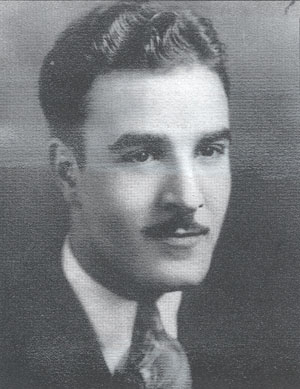 Dr. Louis J. Calli,Sr. as a young man |
Another main stay of local racing was Dave Howard who worked with Russel VanBlaricum and then built his own track on his farm near the state school. Dave was the last harness horse man in town and has only recently retired. Dave was a true horseman who raised, broke, trained, shoed, and was the vet for all his own horses. The Hill family from Bloomington who loaned much of the memorabilia we have here tonight, were major players in the state industry. My brother Sam Calli drove in his first race at 16 and continued driving the rest of his life. He would cover most of the Indiana fair circuit, all through Ohio and Pennsylvania and raced through most major tracks in North America from Winnipeg, Manitoba to New York City. Dad and Sam bought a stud Mahlon Hanover who had been the top two year old in the country and was an early favorite for the Hambletonian, but then went blind. Most of the horses in the stable were home bred but Dad was always trading and buying and at one point we had over 150 horses. Dad would trade frequently with the Amish who prized harness horses for their buggies when they were too old to race.
Sam was well known throughout the tracks as "Singing Sam". He loved to sing and croon, a la Dean Martin and Frank Sinatra and did this at the bars which were after race venues for the drivers. When the race announcer would call horses at the head of the stretch he would yell. "...and here comes Singing Sam on the move".
Every horseman was always waiting for the "big one", the horse that would win them the envy of other horsemen, and race and beat the best. Very few ever won much money but whether it was a $100 claimer or a Hambletonian winner, the real sport was the competition. My fondest memories are of standing at the fence with Dad at our farm, which is now the Violet and Louis Calli Nature Preserve, and watching the new young colts out in the field every year. With the same belief and hope he would always point to one of the foals and say "Look at that gait, he's a natural trotter, that's going to be the one!"
The Author
Dr. Jim Calli was born in Massena, New York in 1946 and moved to North Vernon in 1949. He is a graduate of NVHS Class of 1964 and John Hopkins University 1972, McGill University 1st year 1973, Medical residency 1972, 1973-1982 Adult Medicine in North Vernon. 1982-1984 University of Utah Medical Center. 1984-1986 University to present: Invasive Cardiologist. Clinical Assistant Professor of Medicine-Indiana University Medical School. |
Medical Students-I try to spend more time in teaching and hope I can have an influence to let students see the special privilege medicine is.
Africa-Ann Marie and I have founded Giving Back to Africa in 2003 and this occupies much of our time.
We fund and support an orphanage in Kinshasa, DRC and run a scholar's program for university students at the Protestant University of Congo.
Bicycling-We are fortunate to be able to travel and enjoy mountain terrain riding around the world.
"My life was formed by North Vernon and being fortunate to grow up in an environment of support and wonderful friends. These relationships and my love and gratefulness to this community and my friends only grows with time. Being able to donate the Calli Nature Preserve has been one of my fondest moments. Seeing kids and families and their dogs playing and enjoying the trail give me a great continuing sense of connection with the land I love so much. There is nothing special about me donating it. I'm just lucky enough to have been able to. There was never any question this land should be preserved for people to enjoy it as much as I did."
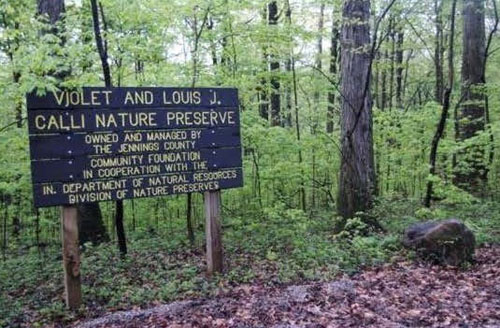
Dr. Calli retires
North Vernon Plain Dealer - June 9, 1996
N. Vernon icon steps down after 65 years as physician
by Bryce Mayer
When Dr. Louis J. Calli, Sr., started practicing medicine in Jennings County in 1949, he was one of only two physicians in the area. The other was Dr.
John Green.
Last week Dr. Calli was finally forced to retire. The 87-year-old doctor fell and broke several ribs, also hampering his recuperation from heart problems which have hampered him recently.
"Dad is doing well after spending the last 2 1/2 weeks in the Bloomington Hospital," said his youngest son, Dr. Louis J. "Jim" Calli, Jr., a cardiologist in Bloomington. "He's as feisty as ever and is anxious to get back to his home in North Vernon.
The senior Calli will be returning to North Vernon this week, but he won't be doing any more doctoring. Instead, he will be recovering from his illness, selling his standardbred horses and answering get-well cards.
A native of Canastota, N.Y., a small town almost entirely populated by Italian immigrants near Syracuse, Calli went to St. John;s University and then attended medical school at St. Louis University.
He had his own hospital, a 10 bed facility, in Massens, N.Y., before he landed in North Vernon nearly 50 years ago.
"Dad got familiar with the area when he was stationed at Fort Knox in the Army," said Jim Calli. "He got interested in horses, too. He liked the North Vernon area and thought it would be a good place for his hobby. Besides, the town needed another doctor."
A doctor since 1933, until last week the senior Calli had been in continuous practice of medicine for 65 years which may be the longest in the county.
"He is very grateful to have been given the privilege to touch so many lives," Jim Calli said. The entire course of his life has been the care of his many wonderful patients whom he will miss dearly. He hopes they will continue to see him as friends now, as he considered all of them friends as well as patients."
Calli's wife, Violet, died over two years ago in an automobile accident near Sellersburg. Sam is the oldest son and still lives in the North Vernon area where he has cared for and trained virtually all of the horses his father has owned. The only daughter of Calli Sr. is Rosemary Lamothe who teaches grade school at Jeckyll Island, Ga.
"A generation is changing. None of us are made like these guys anymore," said Jim Calli who has been a doctor in Bloomington for over 12 years.
"Dad is looking forward to getting back to North Vernon," he said, "Even is he's flat on his back, he's going to be answering the door."
Last week Dr. Calli was finally forced to retire. The 87-year-old doctor fell and broke several ribs, also hampering his recuperation from heart problems which have hampered him recently.
"Dad is doing well after spending the last 2 1/2 weeks in the Bloomington Hospital," said his youngest son, Dr. Louis J. "Jim" Calli, Jr., a cardiologist in Bloomington. "He's as feisty as ever and is anxious to get back to his home in North Vernon.
The senior Calli will be returning to North Vernon this week, but he won't be doing any more doctoring. Instead, he will be recovering from his illness, selling his standardbred horses and answering get-well cards.
A native of Canastota, N.Y., a small town almost entirely populated by Italian immigrants near Syracuse, Calli went to St. John;s University and then attended medical school at St. Louis University.
He had his own hospital, a 10 bed facility, in Massens, N.Y., before he landed in North Vernon nearly 50 years ago.
"Dad got familiar with the area when he was stationed at Fort Knox in the Army," said Jim Calli. "He got interested in horses, too. He liked the North Vernon area and thought it would be a good place for his hobby. Besides, the town needed another doctor."
A doctor since 1933, until last week the senior Calli had been in continuous practice of medicine for 65 years which may be the longest in the county.
"He is very grateful to have been given the privilege to touch so many lives," Jim Calli said. The entire course of his life has been the care of his many wonderful patients whom he will miss dearly. He hopes they will continue to see him as friends now, as he considered all of them friends as well as patients."
Calli's wife, Violet, died over two years ago in an automobile accident near Sellersburg. Sam is the oldest son and still lives in the North Vernon area where he has cared for and trained virtually all of the horses his father has owned. The only daughter of Calli Sr. is Rosemary Lamothe who teaches grade school at Jeckyll Island, Ga.
"A generation is changing. None of us are made like these guys anymore," said Jim Calli who has been a doctor in Bloomington for over 12 years.
"Dad is looking forward to getting back to North Vernon," he said, "Even is he's flat on his back, he's going to be answering the door."
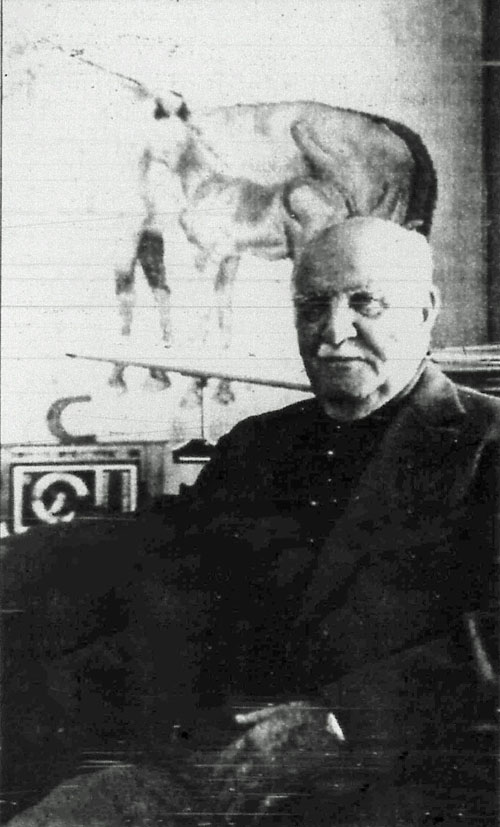
Dr. Louis J. Calli, Sr.
Dr. Calli dies at 88
Physician served Jennings area for 49 years
Dr. Louis J. Calli, Sr., 88, long time Jennings County physician and the Jennings County Health Officer, died at his home at 5:15 p.m. Sunday, March 14, 1999, after an illness.
Dr. Calli started practicing medicine in Jennings County in 1949 and retired in July 1998. He had been a doctor for 65 years and that continuous practice may have been the longest in the country.
For 49 years, Dr. Calli's office at his home on South State Street was open night and day whenever his patients needed him.
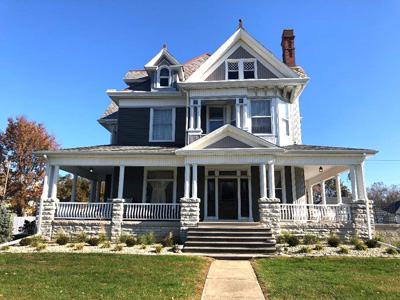
Dr. Calli was named as the Jennings County Health Officer in January 1967 and served in the post until his death.
"He was one grand person," said Mary Wilkerson, county sanitarian, who had worked for him since 1969.
"Dr Calli was very efficient and always on top of things at all times. He was so knowledgeable and a kind considerate person." Just as with his medical practice, Dr. Calli was available for health department business 24 hours a day. "We have it certainly suffer a great loss," Wilkerson said.
Dr. Calli was born August 15, 1910, and graduated from Canastota High School in central New York. He was a 1929 graduate of St. John's University in New York and completed his medical training at St. Louis medical School in 1934.
When Dr Calli was 15 years old he was crowned the Central New York tennis champion and also played on one of the top semi-pro baseball teams in the country when he was 16 - 20.
From 1944-1946, he served as a captain in the army and was stationed at Fort Knox, Kentucky. It was during this time he became acquainted with a Hoosier who was into harness racing. He purchased two standard bred horses at a Lexington, Ky., auction at the time and from then on was involved in horse breeding, training and racing. The Calli colors were well known at area race tracks and three in Ohio including Psioto Downs, Hamilton Raceway and Lebanon. He had many outstanding horses that won a lot of money with his son, Sam, in the sulky.
In an interview in 1995, Dr Calli said he believed he had "a well-rounded life " He stated he had been able to be involved in the things he loved most - sports, medicine and horses.
Dr. Louis J. Calli, Sr., 88, long time Jennings County physician and the Jennings County Health Officer, died at his home at 5:15 p.m. Sunday, March 14, 1999, after an illness.
Dr. Calli started practicing medicine in Jennings County in 1949 and retired in July 1998. He had been a doctor for 65 years and that continuous practice may have been the longest in the country.
For 49 years, Dr. Calli's office at his home on South State Street was open night and day whenever his patients needed him.

Home of Dr. Louis Calli, Sr. (as it looks in 2024). This home was built by Attorney Lincoln Dixon then purchased by Dr. Calli, it is now the Rudicel Family Event Center owned Dove, Sharp & Rudicel Funeral Home.
"A generation is changing, none of us are made like these guys anymore," said Dr. Calli son, Dr. Jim Calli of Bloomington on his father's retirement.Dr. Calli was named as the Jennings County Health Officer in January 1967 and served in the post until his death.
"He was one grand person," said Mary Wilkerson, county sanitarian, who had worked for him since 1969.
"Dr Calli was very efficient and always on top of things at all times. He was so knowledgeable and a kind considerate person." Just as with his medical practice, Dr. Calli was available for health department business 24 hours a day. "We have it certainly suffer a great loss," Wilkerson said.
Dr. Calli was born August 15, 1910, and graduated from Canastota High School in central New York. He was a 1929 graduate of St. John's University in New York and completed his medical training at St. Louis medical School in 1934.
When Dr Calli was 15 years old he was crowned the Central New York tennis champion and also played on one of the top semi-pro baseball teams in the country when he was 16 - 20.
From 1944-1946, he served as a captain in the army and was stationed at Fort Knox, Kentucky. It was during this time he became acquainted with a Hoosier who was into harness racing. He purchased two standard bred horses at a Lexington, Ky., auction at the time and from then on was involved in horse breeding, training and racing. The Calli colors were well known at area race tracks and three in Ohio including Psioto Downs, Hamilton Raceway and Lebanon. He had many outstanding horses that won a lot of money with his son, Sam, in the sulky.
In an interview in 1995, Dr Calli said he believed he had "a well-rounded life " He stated he had been able to be involved in the things he loved most - sports, medicine and horses.
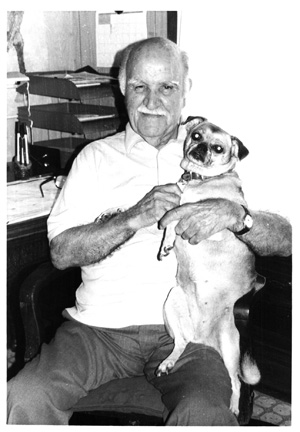
Dr. louis J. Calli
You may use this material for your own personal research, however it may not be used for commercial publications without express written consent of the contributor, INGenWeb, and